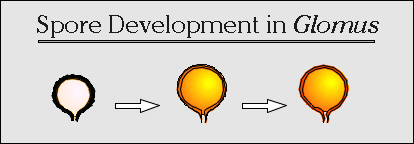Glomus Tul. & C. Tul. emend C. Walker & A. Schüßler
| Term | Description |
|---|---|
| Etymology: | Latin, “a ball of yarn” |
| Description: | Spores glomoid, produced at or near the soil surface, in sporocarps, usually with partial or complete peridium or as spores singly or in clusters in the soil or substrate. With sequences GGTACGYACTGGTATCATTGG and TCGGCTGTAAAAGGCYYTTG in the SSU gene specific for the genus. |
| Type species: | G. macrocarpum Tul. & Tul. |
Schüßler & Walker (2010) indicate a culture has been established of G. macrocarpum and this culture (W5581) has been designated as the ex-epitype of the species. With use of the rDNA sequence data as the sole arbiter of classification in this genus, few species are defined phylogenetically. Despite progress in this area, the genus still is a mess because it now serves as a “container” for all glomoid species for which there is not BOTH morphological and molecular criteria.
Spore Development
Development of spores proceeds by blastic expansion of a hyphal tip as shown below. Intercalary spore formation also has been reported in some species, but its occurrence is much rarer. Outer layers of the spore wall often slough as the spore ages (in soil or in pot culture storage). Developmentally, these layers are the first components of the spore wall to form in juvenile spores. Usually, the outermost layer is mucilagenous, a property which appears to correlate with a dextrinoid (red) reaction in Melzer’s reagent.
The hypha subtending the spore differentiates at the same rate and synthesizes the same component layers as that found in the spore wall. In some species the subtending hypha of mature spores is so thin that it is hard to see or separates from the spore. To separate these sessile-appearing spores from those in Acaulosporaceae, one only needs to examine for completely separated flexible inner walls in crushed spores mounted on a glass slide (present in fungi in Acaulosporaceae, absent in Glomus).
References
- Schüßler, A and C. Walker C. 2010. The Glomeromycota: a species list with new families. Electronic copy available online at Glomeromycota PHYLOGENY.
